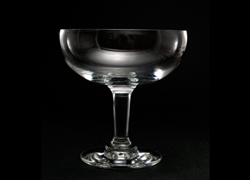How best to worship the perfect breast? Men have long dreamed of sipping fine wine from their lovers’ busts cast in glittering crystal. In antiquity, a temple on the island of Rhodes displayed a goblet believed to have been modeled on the breasts of Helen of Troy by her paramour Paris. In the Middle Ages, love-besotted French king Henry II had his wine cups fashioned on the “apple-like” breasts of Diane de Poitiers. And in the late 1700s, the legend sprang up that Queen Marie-Antoinette’s breasts were the model for the shallow, broad-rimmed champagne coupes that are still often used today. (Although the modern fashion is more for the tall, thin and very un-breast-like champagne flutes).
There is no evidence at all that this is true of Marie-Antoinette, although the Queen did have a passion for bubbly. If nothing else, her ample figure, admired by her letch of a father-in-law King Louis XV and others, would have provided a higher-volume glass than the shallow coupes. But the royal breast-stemware connection may have begun with another, slightly more plausible story: Marie-Antoinette definitely did have a set of breast-shaped porcelain milk bowls created for her by the French porcelain factory, Sèvres – and tradition holds that they were modeled on her own. Known as the jattes tetons, the creamy white gourds balance on a tripod base that is decorated with carved goat’s heads. Marie-Antoinette was a devotee of the “back-to-Nature” movement that brought breast-feeding back into fashion in France, and she had ordered the cups for use at her fairy-tale dairy Rambouillet, where the queen liked to dress up as a shepherdess and frolic with her children and ladies-in-waiting. The shamefully expensive service was delivered during the troubled year of 1788, the year before the Revolution exploded.
If the story is true, the cast of the Queen’s breast would probably have been made from wax under the control of one Jean-Jacques Lagrenée, the factory’s co-artistic director. The four original bowls survive in the Musée National de Céramique de Sèvres in Paris, and the porcelain company still makes reproductions for connoisseurs.
SOURCE/FURTHER READING: Yalom, Marilyn, History of the Breast, (New York, Knopf 1997); Caroline C Yung, “Marie-Antoinette’s Dairy at Rambouillet,” Antiques Magazine, (October, 2000); Antonia Fraser, Marie Antoinette: The Journey, (New York, Doubleday 2002).
A New Contender
The most recent breasts supposed to have inspired champagne coupes belong to the American model and photographer Lee Miller. As she cut a swathe through 1930s Paris as the lover of surrealist artist Man Ray, Miller was widely regarded to have the most beautiful breasts in the city – thus, it’s said, inspiring a French glass company to model a new coupe on her form. Miller’s lovely figure appeared in many Man Ray images, but was discreetly hidden when, as a war photographer in 1945, she posed naked in Hitler’s bathtub in liberated Munich. •




